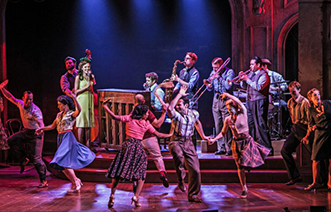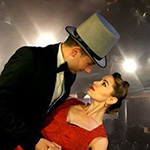The Bandstand
Paper Mill Playhouse, Millburn, NJ, October 19, 2015
Reviewed by Chip Deffaa for Cabaret Scenes
 I give lots of credit to Paper Mill Playhouse, which has courageously launched its new season with a wholly original musical—a musical not based on any pre-existing film, play, or book. And it’s a pretty good one. It’s not ready to transfer to Broadway just yet, but there’s much to appreciate in The Bandstand. Go see it, if you can. There are some excellent performances, an engrossing storyline, some swinging songs that pull you along—in sum, the show has many of the materials needed for a successful musical. The production has its share of shortcomings, as well, alas. And I hope the creative team can address them, in time. But there’s much to enjoy right now. I’d like to see this musical have a future.
I give lots of credit to Paper Mill Playhouse, which has courageously launched its new season with a wholly original musical—a musical not based on any pre-existing film, play, or book. And it’s a pretty good one. It’s not ready to transfer to Broadway just yet, but there’s much to appreciate in The Bandstand. Go see it, if you can. There are some excellent performances, an engrossing storyline, some swinging songs that pull you along—in sum, the show has many of the materials needed for a successful musical. The production has its share of shortcomings, as well, alas. And I hope the creative team can address them, in time. But there’s much to enjoy right now. I’d like to see this musical have a future.
The show tells the story of a group of veterans, right after World War II has ended, joining together to form a small swing band to compete in a national radio competition. The psychic wounds of war are still pretty raw for these guys. But, they’re determined to give it their all.
Cory Cott (who’s previously starred on Broadway in Gigi and Newsies) is excellent as the driven, angsty leader of the pack. Laura Osnes (who was nominated for a Tony for her starring performance in Rodgers + Hammerstein’s Cinderella) finds an appealing mix of sweetness and strength playing the female love interest/band singer. She’s not really ideal for the part, though; she has a beautiful, legit musical-theater voice. Someone who swings more would serve the show better. Beth Leavel, who won the Tony Award for her work in The Drowsy Chaperone on Broadway is just plain wonderful in a small-ish supporting role. She was my favorite in the cast and I wished she could have had more to do; her presence, her timing, her feel for musical comedy are all first-rate.
I was drawn into the story right away. I like the way director/choreographer Andy Blankenbuehler staged the first scene. We see soldiers on the battlefield, with the percussive music simultaneously conjuring up the Big Band era (evocations of Benny Goodman’s immortal “Sing Sing Sing”) and bombs in wartime. And then there’s the leading character coming home from the war, vainly hoping everything will be as it was before.
Small problems marred my pleasure. For example, I could not understand the very first words heard in the show—they were drowned out by music. They were the only words I could not make out the entire night. But, first impressions count.
I liked the arc of the story, the surprising plot turns, and many of the songs. Occasionally, the story got a tad melodramatic (which isn’t as appealing as dramatic). When one of the returning vets spoke of three of his friends having committed suicide, that struck me as dramatic overkill. The writers clearly wanted us to understand that post-traumatic stress syndrome is real. And it is. But a reference to one friend killing himself to end the nightmares of war would hit harder emotionally, if phrased right, than a reference to three.
Sometimes the show’s creators—Robert Taylor and Richard Oberacker—threw in touches that evoked the period well (a reference in the lyrics to “Ella singing and Dorsey swinging”). Sometimes, though, lines misfired, as if the writers don’t really know the period well enough. And such misfires took me out of the period. For example, the reference to the sextet being booked for “a concert” at the Rainbow Room missed the mark; no one was booked for “a concert” at the Rainbow Room. It was a posh spot for dining and dancing to big bands. A reference to the New Amsterdam Roof was also odd; it was active in a much earlier era, and forgotten by the 1940s. I didn’t buy the notion that their combo would ever be booked to play (as the script stated twice in one scene) only one set, lasting a mere 30 minutes. Any venue booking a live band in the mid-1940s (and paying the era’s steep entertainment tax) would want to get as much out of the musicians as possible. Patrons would want more than just 30 minutes of music, as well.
The show builds to a climax with the number “Welcome Home.” But, for me, the moment was weakened because the onstage band (with actors playing their own instruments) did not sound very good. (Trumpeter Joey Perro was excellent, I should note, but the band’s blend was not satisfactory.) And the actor walking about, playing his sax with what was intended to be emotional intensity (because the song about the horrors of war meant so much to him), merely seemed to be over-acting.
I liked the freshness of the storyline. And there were some scenes that were just perfect (any interaction between Osnes and Leavel). Overall, it’s a pretty good first mounting of a big, ambitious show. Developing an original musical is hard. This one isn’t yet where it should be. I hope the creators can do the necessary tweaking so that the show will be in better shape, next time around.





